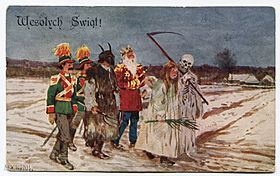Christmas in Poland facts for kids
Quick facts for kids Christmas in Poland |
|
|---|---|
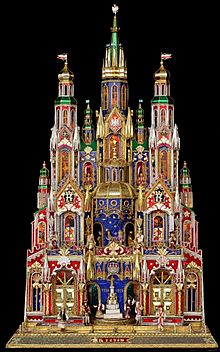
Nativity scene (szopka) by Bronisław Pięcik, UNESCO Intangible Cultural Heritage
|
|
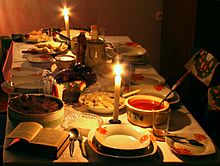
Christmas Eve Supper
|
|
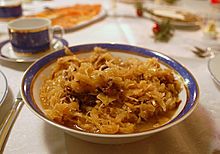
Traditional Christmas Day dinner serving of bigos on December 25
|
|

Christmas markets are held in every major city, especially in Kraków (pictured)
|
|
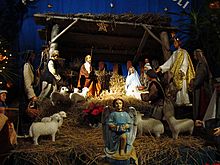
Nativity scene at the Catholic Church of Christ the King in Sanok
|
|
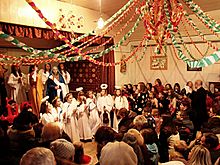
Nativity play (Jasełka or Herody) by children
|
|
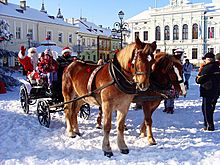
Kulig with Saint Nicholas
|
Christmas in Poland is a very important yearly celebration. It's like in many other Christian countries. Christmas traditions in Poland grew over many centuries. They mix old Polish customs with new religious ones. These were brought in by the Catholic Church after Poland became Christian. Local traditions and different folk cultures also added to the mix. It is one of the most important religious holidays for Poles. They follow many old customs. Christmas trees are decorated and lit in homes on Christmas Eve. Other trees are put in public places and outside churches. Christmas in Poland is called "Boże Narodzenie". This means 'God's Birth'.
The Day of Saint Nicholas on December 6 is the start of the holiday season. Good children get small gifts that day. Naughty children might get a lump of coal or a twig called "rózga". The main day of the holiday is Christmas Eve on December 24. Polish Wigilia (Christmas Eve supper) starts when the first star appears. This star reminds people of the Star of Bethlehem. During preparations, hay is placed under the tablecloth. This reminds everyone that Jesus was born in a manger. An empty place setting is often left at the table. This is for the Lord or for a lost traveler who might need food. The supper begins by breaking the Christmas wafer called "opłatek". This custom is mostly found in Poland and two other countries. The meals must be vegetarian (except for fish). This shows a sign of fasting. Twelve different dishes are made, symbolizing the Twelve Apostles. The celebration ends with exchanging gifts and a Midnight Mass in churches.
Other Polish Christmas traditions include nativity plays called "Jasełka" or "Herody". There are also outdoor nativity scenes. People sing carols, especially "God Is Born". Another tradition is Kulig, a sleigh ride pulled by horses. The tradition of making Christmas szopkas in Kraków is very special. It has been recognized by UNESCO as an important cultural heritage.
Contents
Advent: Getting Ready for Christmas
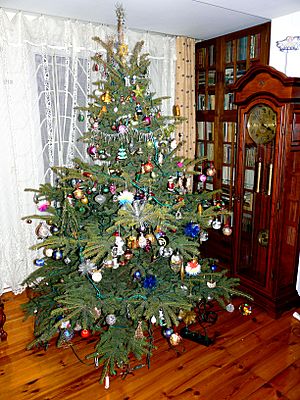
During Advent, which is a time of waiting for Christmas, families do special things. They bake Christmas piernik (gingerbread) and make decorations. Pierniks come in many shapes, like hearts, animals, and St. Nicholas figures. St. Nicholas is not the main focus on Christmas Day. But he is celebrated on his feast day, December 6. He secretly visits good children and leaves them presents.
Christmas trees are usually decorated with glass baubles and garlands. Many homemade ornaments are also used. These include painted eggshells, shiny red apples, walnuts, and wrapped chocolates. Candles are also lit on the tree. Trees are lit on Christmas Eve before Wigilia. A star or a sparkling Tree-topper is placed at the top of each tree. In some homes, sparklers are hung on the branches. This creates a wintery mood. Sometimes, trees stay up until February 2. This is the feast day of St. Mary of the Candle of Lighting.
During Advent and until Epiphany (January 6), "gwiazdory" or star carriers walk through villages. Some sing carols. Others recite poems or perform "szopki" or "herody" (nativity scenes). These customs are inspired by traditional manger scenes or "Jasełka" (crib). A special Polish tradition is sharing the "opłatek". This is a thin wafer with a holy picture pressed into it. In the past, people carried these wafers from house to house. They wished their neighbors a Merry Christmas. Today, opłatek is mostly shared with family and close neighbors. This happens before the Christmas Eve supper (Wigilia). As people share pieces of the wafer, they forgive each other for any past hurts. They also wish each other happiness for the coming year.
Wigilia, the Christmas Eve Supper
In Poland, Christmas Eve is first a day of fasting. Then it becomes a day of feasting. The Wigilia feast starts when the first star appears in the sky. No red meat is served, but fish is common, usually carp. The supper has many traditional dishes and desserts. It can sometimes last for over two hours. After the meal, gifts are exchanged.
The next day, Christmas Day, is often spent visiting friends. In Polish tradition, Christmas brings together religion and family closeness. Giving gifts is important. But the focus is more on making special foods and decorations.
On Christmas Eve night, the first star is very important. It reminds people of the Star of Bethlehem. It is lovingly called "the little star" or Gwiazdka. Children watch the sky eagerly. They hope to be the first to shout, "The star has come!" Only after it appears do family members sit down to dinner.
The supper begins with breaking the opłatek wafer. Everyone at the table breaks off a piece and eats it. This symbolizes their unity. Then they share a piece with each family member.
A traditional Wigilia supper in Poland includes fried carp. It also has borscht (beetroot soup) or mushroom consommé with uszka (ravioli). Carp is a main part of the Christmas Eve meal across Poland. You might find carp fillet, carp in aspic, and gefilte fish. Common Polish Christmas foods are pierogi and some herring dishes. For dessert, there is makowiec or noodles with poppy seeds. Often, a compote of dried fruits is served as a drink.
The rest of the evening is spent with stories and songs around the Christmas tree. In some areas, children are taught that "The Little Star" brings gifts. As presents are unwrapped, carolers might walk from house to house. They receive treats along the way.
Christmas Eve ends with "Pasterka", the Midnight Mass at the local church. This tradition remembers the shepherds arriving in Bethlehem. They came to show respect to the newborn Messiah. The custom of a Christmas night church service started in Christian churches after the 5th century. In Poland, this custom arrived with Christianity. The next day (December 25) starts with an early morning mass. This is followed by daytime masses.
Wigilia Traditions
Bits of hay are spread under the tablecloth. This reminds everyone that Jesus was born in a manger. Some people place money under the tablecloth for each guest. This is to wish for good luck in the coming year.
Some believe that an even number of people must sit around the table. In many homes, an empty place setting is left. This is for the Baby Jesus. Or it can be for a lonely traveler who might need food. It can also be for a deceased relative who might want to share the meal.
Some families serve twelve different dishes at Wigilia. This symbolizes the Twelve Apostles. Or, sometimes, an odd number of dishes (like five, seven, or nine) are served for good luck.
Kolędy, Polish Christmas Carols
Christmas carols are sung in Poland during and after the Christmas Vigil Mass. This mass is called "Pasterka" and is held between December 24 and 25. The Christmas season often lasts until February 2. Early hymns were brought to Poland by the Franciscan Brothers in the Middle Ages. The first Christmas music was in Latin. Later, Polish words and melodies became popular. Many new secular songs, called "pastoralka" (shepherd's songs), were created. They were not written down at first. People learned them by heart. The song "God Is Born" (Bóg się rodzi) is very famous. Franciszek Karpiński wrote the lyrics in 1792. It became Poland's Christmas hymn. Many early Polish carols were collected in 1838. This was done by Michał Mioduszewski in a book called Pastorałki i Kolędy z Melodiami.
Polish Hand-Made Christmas Ornaments
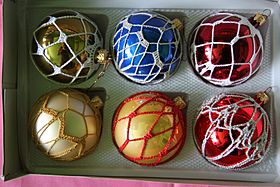
Poland makes some of the best hand-blown glass Christmas ornaments in Europe. Families and collectors love these ornaments. They are known for their high quality, traditional art, and unique designs.
Polish blown-glass Christmas ornaments are usually made only during the winter. Modern glass workshops and factories are mostly found in southern Poland.
See also
 In Spanish: Navidad en Polonia para niños
In Spanish: Navidad en Polonia para niños
- Easter in Poland
- God Is Born
- Kraków szopka
- Wigilia the Christmas Eve vigil supper
- Christmas worldwide


